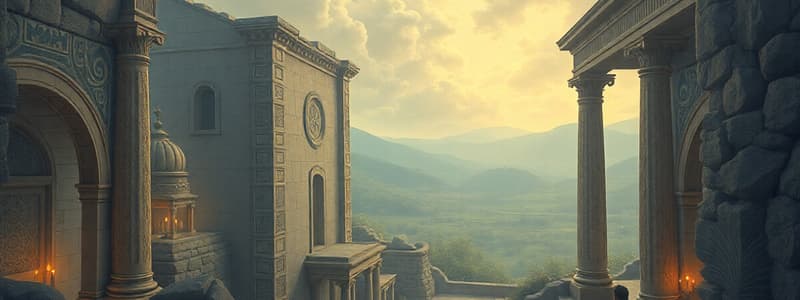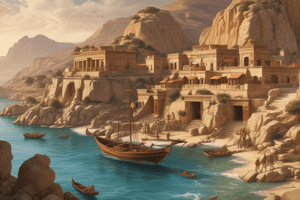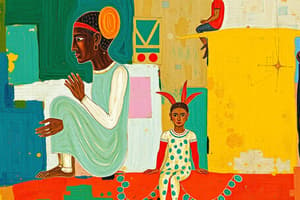Podcast
Questions and Answers
Geografske prepreke su sprečile formiranje jedinstvene grčke države.
Geografske prepreke su sprečile formiranje jedinstvene grčke države.
True (A)
Grci su sebe nazivali Dorianima i svoju zemlju Eldorijom.
Grci su sebe nazivali Dorianima i svoju zemlju Eldorijom.
False (B)
Sparta je smatrana najjačom polisom među Dorianima.
Sparta je smatrana najjačom polisom među Dorianima.
True (A)
Heloti su bili puni građani Sparte koji su imali politička prava.
Heloti su bili puni građani Sparte koji su imali politička prava.
Vladavina u Arhaičkoj Grčkoj je uključivala oblike vlasti kao što su demokratija i tiranija.
Vladavina u Arhaičkoj Grčkoj je uključivala oblike vlasti kao što su demokratija i tiranija.
Lakedaemon je bio sinonim za Atinu, najpoznatiju grčku polis.
Lakedaemon je bio sinonim za Atinu, najpoznatiju grčku polis.
Agoge je vojska obuka koja se sprovodila u Sparte od sedme godine života.
Agoge je vojska obuka koja se sprovodila u Sparte od sedme godine života.
Velika Rhetorika je uspostavila oblik vladavine u Atini.
Velika Rhetorika je uspostavila oblik vladavine u Atini.
Spartanska vlast je bila vođena od strane jednog kralja kako bi se sprečila tiranija.
Spartanska vlast je bila vođena od strane jednog kralja kako bi se sprečila tiranija.
Gerousia je bila skup od 28 muškaraca starijih od 60 godina koji su imali kontrolu nad vojnim snagama Sparti.
Gerousia je bila skup od 28 muškaraca starijih od 60 godina koji su imali kontrolu nad vojnim snagama Sparti.
U Atini, proces sinokizma doveo je do ujedinjenja manjih zajednica u jedan grad.
U Atini, proces sinokizma doveo je do ujedinjenja manjih zajednica u jedan grad.
Drako je bio poznat po uvođenju blage i pravedne pravne regulative u Atini.
Drako je bio poznat po uvođenju blage i pravedne pravne regulative u Atini.
Ateška skupština, poznata kao Ecclesia, sastojala se od svih građana Atine i bila je vrhovno zakonodavno telo.
Ateška skupština, poznata kao Ecclesia, sastojala se od svih građana Atine i bila je vrhovno zakonodavno telo.
Kodros je bio prvi kralj Atine i poznat je po svom dugom vladavini.
Kodros je bio prvi kralj Atine i poznat je po svom dugom vladavini.
U atinskoj društvenoj hijerarhiji, metici su imali pune političke prava kao i Eupatridae.
U atinskoj društvenoj hijerarhiji, metici su imali pune političke prava kao i Eupatridae.
Solon je ukinuo dužničko ropstvo zbog zahteva za reformama.
Solon je ukinuo dužničko ropstvo zbog zahteva za reformama.
Sistem vlasti u arhaičnoj Atini poznat je kao demokratija, gde su svi građani učestvovali u donošnjem odluka.
Sistem vlasti u arhaičnoj Atini poznat je kao demokratija, gde su svi građani učestvovali u donošnjem odluka.
Tvorac timokratije je bio Pisistratus.
Tvorac timokratije je bio Pisistratus.
Ostrakizam je bio način da se spreči povratak tiranije u Atini.
Ostrakizam je bio način da se spreči povratak tiranije u Atini.
Pisistratus je stvorio prosperitet pre svega za bogate građane Atine.
Pisistratus je stvorio prosperitet pre svega za bogate građane Atine.
Perikles je uveo radikalnu demokratiju u Atini.
Perikles je uveo radikalnu demokratiju u Atini.
Plemstvo je biralo sve članove Saveta 500 u Atini.
Plemstvo je biralo sve članove Saveta 500 u Atini.
Hippias i Hipparchus su nasledili vlast od Solona.
Hippias i Hipparchus su nasledili vlast od Solona.
Tiranija u Atini je okončana zahvaljujući Spartanima 510. godine pre nove ere.
Tiranija u Atini je okončana zahvaljujući Spartanima 510. godine pre nove ere.
Flashcards
Sparske kraljeve
Sparske kraljeve
Dva kralja iz različitih dinastija (Agijadi i Euripontidi) koji su vodili spartansku vladu.
Gerousia
Gerousia
Savet starijih u Sparta, sastavljen od 28 muškaraca starijih od 60 godina, uključujući i dva kralja.
Efori
Efori
Pet građana koji su nadzirali kraljeve u Sparta, imali policijska ovlašćenja i organizovali vojsku.
Atinska konstitucija
Atinska konstitucija
Signup and view all the flashcards
Demokratija
Demokratija
Signup and view all the flashcards
Drakon
Drakon
Signup and view all the flashcards
Solon
Solon
Signup and view all the flashcards
Arhonti
Arhonti
Signup and view all the flashcards
Grčki gradovi-države
Grčki gradovi-države
Signup and view all the flashcards
Sparta
Sparta
Signup and view all the flashcards
Sparćani
Sparćani
Signup and view all the flashcards
Agoge
Agoge
Signup and view all the flashcards
Herodot
Herodot
Signup and view all the flashcards
Velika Retra
Velika Retra
Signup and view all the flashcards
Solonovljeve reforme
Solonovljeve reforme
Signup and view all the flashcards
Savez od 400
Savez od 400
Signup and view all the flashcards
Ostracizam
Ostracizam
Signup and view all the flashcards
Kleishtenove reforme
Kleishtenove reforme
Signup and view all the flashcards
Savez od 500
Savez od 500
Signup and view all the flashcards
Periklovo doba
Periklovo doba
Signup and view all the flashcards
Skupština (Eklezija)
Skupština (Eklezija)
Signup and view all the flashcards
Study Notes
Ancient Greece
- Ancient Greece's Bronze Age began around 2700 BCE.
- Key Bronze Age cultures were Minoan (Crete) and Mycenaean.
- The earliest period in Ancient Greek history is the Minoan-Mycenaean period, due to connections between Crete and mainland Greece.
- Minoan civilization is also called the Cretan civilization.
- Crete used Linear A script, but it's undeciphered due to unknown language family.
- Arthur Evans discovered the Minoan civilization.
- Major Minoan palaces were located in Knossos, Festos, Malia, and Hagia Triada.
- The Minoan economy relied on sea trade and agriculture.
- Minoan civilization reached its peak under King Minos in the 2nd millennium BCE.
- The civilization's influence extended to Aegean islands and mainland Greece.
- The concept of "thalassocracy" describes Minos's naval power to control trade routes.
- The Minoan civilization's fall was likely caused by volcanic eruption and tsunami in the 15th century BCE.
- The Achaeans (Greeks) conquered Crete.
Mycenaean Civilization
- The Mycenaean civilization was led by the Achaean people.
- They adopted the Minoan culture's advancements.
- Historians call this period in Greek history the Mycenaean period, lasting from the 16th to 12th centuries BCE.
- Important Mycenaean centers were Mycenae, Pylos, Tiryns, Thebes, Orchomenos, and Athens.
- Mycenaean kings were known as "wanax."
- Heinrich Schliemann unearthed Mycenae.
- The famous golden mask from Mycenae was linked to the myth of King Agamemnon.
- Mycenae's main entrance was called the Lion Gate.
- The Mycenaeans used Linear B script, deciphered by Michael Ventris and John Chadwick, revealing an early form of Greek.
- The Trojan War is considered the final major event of the Mycenaean period, with its dates, given by Greek tradition, from 1194 to 1184 BCE.
Dark Ages
- The Dorian migration followed the Mycenaean period's collapse.
- Thucydides dated the Dorian conquest of Mycenae around 1104 BCE, 80 years after the fall of Troy.
- The period following the Mycenaean collapse is called the "Dark Ages" from roughly 1100 BCE to 800 BCE.
- The Dark Age features a decline in trade, population, and literacy.
- The only written sources from this period are the Homeric epics, the Iliad and the Odyssey.
- Iron use began in this period.
- The Greeks started settling on the western coast of Asia Minor, establishing colonies or Ionian cities.
- Important cities of the Ionian League were Ephesus and Miletus.
Archaic Period
- The Archaic Period started around 750 BCE and ended around 499 BCE.
- The Archaic Period was a period of significant political and social change.
- Mountainous terrain and rugged coasts made the formation of single Greek state impossible.
- The shared elements of Greek culture included language, religion, and customs.
- The Greeks called themselves Hellenes, and their land Hellas.
- The Greek alphabet emerged in the 8th century.
- The alphabet was adopted and modified from the Phoenicians.
- The polis (city-state) became a prominent form of government in Greece.
- Types of government included aristocracy, oligarchy, democracy, tyranny, and plutocracy.
Classical Period
- The Classical Period began in 479 BC, when the Greek victory over the Persian Empire ended the Persian invasions.
- The period of the Classical period, which began from 479 BCE, was a time of significant political and cultural flourishing.
- Athens developed as a powerful city-state, and the period saw the rise of Athenian democracy under figures like Pericles.
- Key political institutions included the Council of the Areopagus (Areopagus) and the Assembly (Ecclesia).
- The Peloponnesian War (431–404 BCE) pitted Athens against Sparta.
- Major figures of this time include Pericles, who was Athens' leader during much of this period.
Hellenistic Period
- The Hellenistic period started after Alexander's conquests of the Persian Empire (around 336 BCE) and ended when the Roman Republic conquered Greece.
- Alexander's conquests blended Greek and Asian cultures.
- Key figures of this time include Alexander the Great, who fostered the spread of Greek culture eastwards.
- His tutor was Aristotle, a philosopher.
- A group of successors known as the "Diadochi" took over after Alexander's death and formed new Hellenistic kingdoms.
Studying That Suits You
Use AI to generate personalized quizzes and flashcards to suit your learning preferences.




